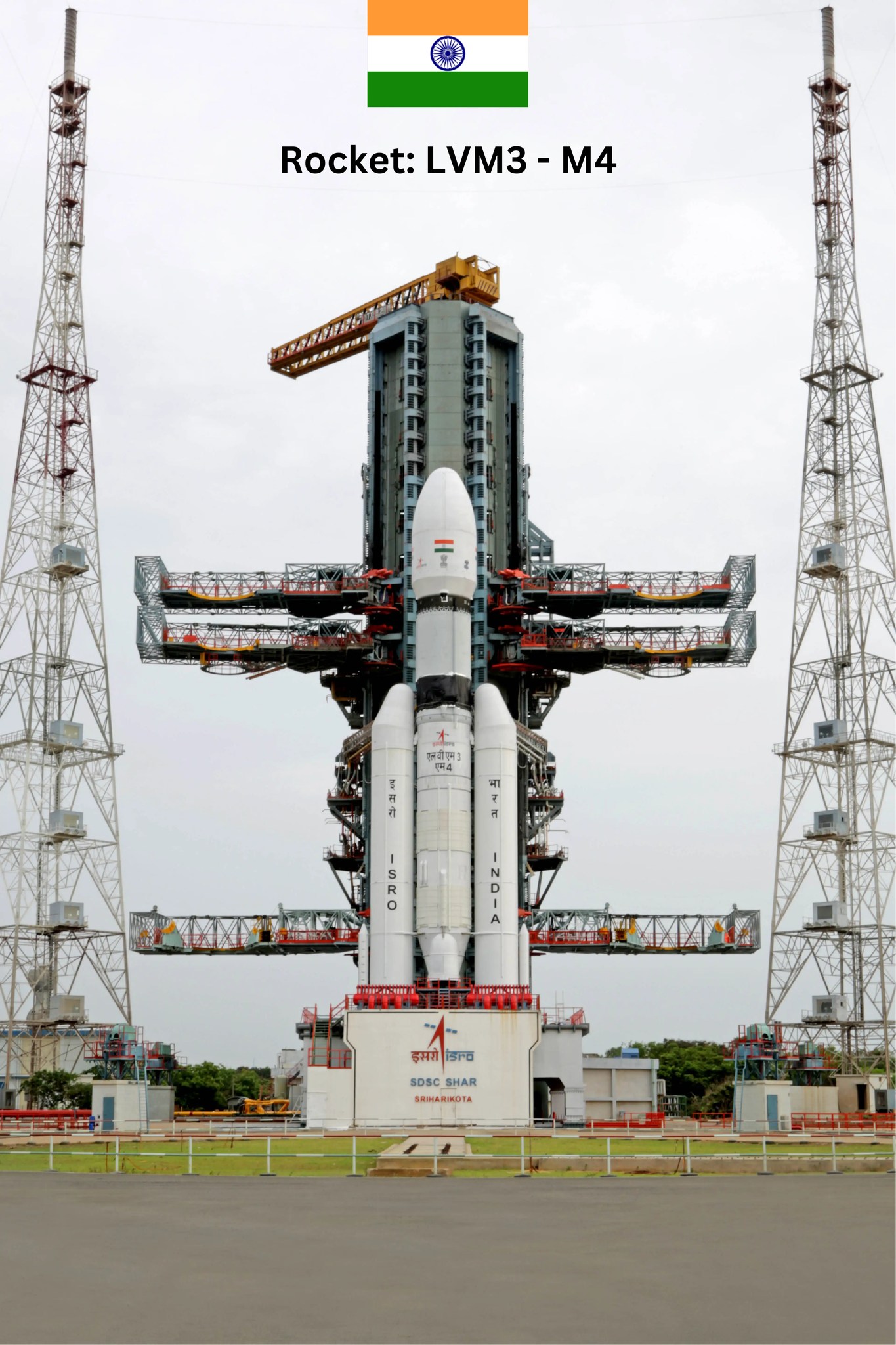Table of Contents
Introduction:
In space exploration, India continues to make remarkable advances with each new mission. Chandrayaan-3 stands as an evidence to India’s commitment to scientific advancement and space innovation. Building upon the successes of its predecessors, Chandrayaan-1 and Chandrayaan-2, this mission is poised to unravel even more secrets of the Moon and contribute to humanity’s expanding knowledge of our cosmic neighbour.
The Birth of Chandrayaan-3
The Indian Space Research Organisation (ISRO) has been a prominent player in the global space community for decades. Its Chandrayaan missions have gathered international acclaim and admiration. Chandrayaan-1, launched in 2008, made significant contributions, including the discovery of water molecules on the lunar surface. Chandrayaan-2, launched in 2019, aimed to further enhance our understanding of the Moon by including an orbiter, lander, and rover.
While Chandrayaan-2’s orbiter successfully continues to send valuable data from its lunar orbit, the lander and rover faced unexpected challenges during their descent. The lander, Vikram, lost communication during its final approach, leading to somewhat bitter outcome for the mission. Determined, ISRO decided to take another shot at lunar exploration with Chandrayaan-3, demonstrating its commitment to pushing the boundaries of space science.
Consecutively, Chandrayaan 3 launched on 14th July 2023 at 2:35 p.m., on a GSLV Mark 3 (LVM 3) heavy lift launch vehicle from Satish Dhawan Space Center in Sriharikota (SDSCS), India. This will be followed by a number of maneuvers over about 40 days to bring it to the Moon.

Chandrayaan-3: Components
Chandrayaan-3 represents a focused effort to achieve a successful lunar landing. The mission comprises a Lander, a Rover and a Propulsion Module (PM) , much like its predecessor. However, Chandrayaan-3 is designed to learn from the experiences of Chandrayaan-2, aiming for a smoother descent and landing process.
- Lander: The lander is a critical component of the mission, responsible for the controlled touchdown on the lunar surface. It will house the rover and carry scientific instruments to conduct experiments and gather data about the Moon’s composition, atmosphere, and surface.

- Rover: The rover is a mobile laboratory, equipped with advanced instruments to explore the lunar surface. It will analyse soil samples, study the Moon’s geology, and perform experiments to deepen our understanding of its evolution and history.

- Scientific Payload: Chandrayaan-3 will carry a suite of scientific instruments to accomplish its research goals. These instruments might include cameras, spectrometers, seismometers, and more, each designed to reveal specific insights about the Moon.
Mission Objectives
- Soft Landing Success: The primary objective of Chandrayaan-3 is to demonstrate India’s capability to achieve a successful soft landing on the lunar surface. This achievement would mark a significant milestone in India’s space exploration journey and pave the way for more complex missions in the future.
- To demonstrate Rover roving on the moon
- To conduct in-situ scientific experiments: Similar to its predecessors, Chandrayaan-3 will carry scientific instruments to analyse the Moon’s surface, composition, and other relevant factors. This data will contribute to a better understanding of the Moon’s geological and mineralogical properties.

Exploration Goals
The Chandrayaan-3 mission holds immense scientific significance. By focusing on a successful lunar landing, it aims to achieve several critical objectives:
Surface Characterization: The rover’s mobility and scientific instruments will allow for an in-depth analysis of the lunar surface. This analysis will shed light on the Moon’s mineral composition, helping scientists understand its geological history and evolution.
Geological Insights: Chandrayaan-3’s experiments will provide valuable data about the Moon’s tectonics, seismic activity, and volcanism. These insights will contribute to our understanding of the Moon’s internal structure and processes.
Water Ice Detection: Building on Chandrayaan-1’s discovery of water molecules, Chandrayaan-3 might further explore the presence of water ice in permanently shadowed regions of the Moon. This has profound implications for future lunar exploration and potential resource utilization.
Challenges and Future Prospects
The successful landing on the Moon’s surface is the prime challenge. The complexities of landing on an extra-terrestrial body, managing continuous communication, and ensuring the health of the on-board instruments all present difficult hurdles.
However, the lessons learned from Chandrayaan-2’s experiences have undoubtedly informed the design and execution of Chandrayaan-3. ISRO’s meticulous approach to problem solving and its dedication to continuous improvement will play a pivotal role in overcoming these challenges.
Chandrayaan-3: Present Status
- On August 1, it was successfully inserted into the translunar orbit
- Four days later, on August 5, it entered the lunar orbit
- On August 9, reached even closer to the Moon, it’s orbit is reduced to 174 km x 1437 km following a third manuevre performed.
On August 6, ISRO shared onboard image of Moon by Chandrayan-3.
For further live update of Chandrayan-3, you can visit official website of ISRO on the link : https://www.isro.gov.in/Chandrayaan3.html

Expected date for landing
Chandrayan-3 is expected to land on South pole of Moon near Manzinus Crater on 23rd August 2023 after 40 days of space travel.
Chandrayaan-3: Mission Life
Mission Life (Lander & Rover) of Chandrayan-3 is one Lunar Day (which is equivalent to 14 earth days).
Conclusion
The Chandrayaan-3 mission is a testament to human curiosity, innovation, and determination. With its aim to successfully land a rover on the lunar surface, India’s space agency, ISRO, is poised to make significant contributions to our understanding of the Moon and its role in the universe.
By building on the successes and lessons of the previous Chandrayaan missions, Chandrayaan-3 represents a crucial step towards unlocking the Moon’s secrets. As the mission unfolds, the world will watch with anticipation, ready to celebrate the achievements and discoveries that Chandrayaan-3 is poised to deliver.
FAQs:
Q1. How Chandrayaan-3 different from Chandrayaan-2?
A1: Chandrayaan-3, primarily focused on achieving a successful soft landing on the Moon’s surface. It aims to build upon the lessons learned from Chandrayaan-2, which included an orbiter, a lander, and a rover. While Chandrayaan-2’s rover was unable to land as intended, Chandrayaan-3 focuses solely on perfecting the landing aspect.
Q2. What are the key components of Chandrayaan-3?
A2: Chandrayaan-3 is consist of a Vikram lander and Pragyan rover and a Propulsion module (PM), similar to the configuration of Chandrayaan-2. The lander is designed to safely land on the lunar surface, while the rover will carry scientific instruments to conduct experiments and gather data.
Q3. What are the challenges of soft landing on the Moon?
A3: Soft landing on the Moon is a complex process as there is no atmosphere on the Moon and there need to be precise control during the descent. Factors such as gravitational variations, terrain irregularities, and communication delays pose challenges that engineers must carefully address to ensure a successful landing.
Q4. What are the potential benefits of discovering water ice on the Moon?
A4: The discovery of water ice on the Moon could have significant implications for future lunar exploration, including the production of drinking water, oxygen, and rocket fuel, which could support extended missions and even human habitation.
If you are interested in reading Tech Blogs then you can click links below:
-
Future of Electric Vehicles in India: Accelerating Towards Sustainable Mobility
-
From Dreams to Reality: How Hydrogen Fuel Cars are Shaping the Future of Transportation in India
If you want to read about key differenes between Chandrayaan-3 Vs Luna-25, you can read the article in the link: Chandrayaan-3 Vs Luna-25, Who will win the race?


4 thoughts on “Chandrayaan-3: Complete info, Update, Landing, Images”